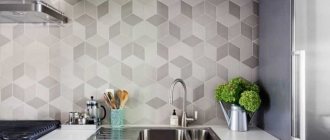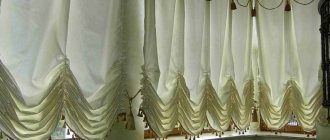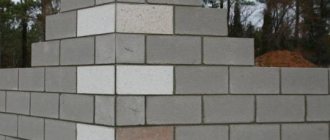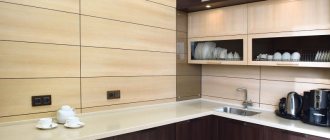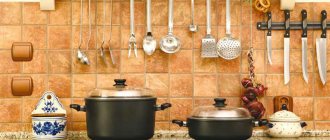A kitchen apron gives the cooking room a special charm that can hardly be achieved in any other way. This concept should not be confused with an element of a chef's clothing. An apron, in this case, is an interior design option that “encircles” a wall or part of it.
It helps not only aesthetically, but also in terms of dividing the kitchen into functional areas. An apron makes this much easier. This is why it has become so popular in kitchens all over the world.
Decorating a mosaic kitchen apron
It can be decorated from various materials, such as ceramic tiles. It all depends on the general style of the room, what the owners’ budget is, and what the features of the wall are.
But, of course, the apron will be as aesthetically pleasing as possible if it is made of a material such as mosaic.
This option for kitchen design turns out to be very aesthetic, it looks interesting and original. This is why mosaics in kitchen design are becoming more and more popular.
It has been used to decorate various rooms for a long time, but recently it has been undeservedly forgotten. In terms of beauty and effectiveness, there can hardly be anything more beautiful than mosaic. So in the last few years it has been experiencing a real renaissance.
Instead of an afterword
The photos in the article show how impressive a kitchen work area decorated with mosaic tiles can look. Now you know about the advantages and disadvantages of this material, its sizes and types, as well as how to install the apron yourself. With these instructions, your kitchen will be stylish and unusual.
Gallery
Did you like the article? Subscribe to our Yandex.Zen channel
Great article 0
Advantages and disadvantages
Mosaic tiles are like any other interior design element. It has both advantages and disadvantages. Only you can decide whether to use a mosaic backsplash in your kitchen.
The following factors speak in favor of installing this design:
- High aesthetics , originality of the resulting apron.
- Durability . Mosaic tiles are a durable material that is difficult to damage or destroy; scratches and other problems are practically invisible on it.
- Filling the room with light , since many of the mosaic materials have a mirror effect, which helps to enhance the lighting in the room.
- Perfect for a kitchen in any style , from modern to classic.
- Caring for a mosaic apron requires the most primitive : it is enough to clean it with a cloth from dirt and dust.
But there are also factors that speak against the use of mosaic as a finishing material:
- High price. Almost any similar finishing material will cost less;
- Difficult to install. Since the mosaic has small dimensions, it is very difficult to lay it, this requires certain qualifications and experience;
- If one of the elements is damaged, problems may arise in finding a completely similar one..
A mosaic apron definitely has more advantages than disadvantages, but this design is suitable mainly for people with a fairly large budget for renovation work.
This is due to the considerable price of the material itself, as well as the fact that you will have to pay a certain amount to the craftsmen who, most likely, will do the installation.
Caring for a mosaic backsplash
Such surfaces must be cleaned thoroughly, following some standard rules:
- You cannot wipe off dirt from the surface of glass and glossy elements with abrasive powders and hard sponges, as this will lead to scratches. The gloss will lose its effectiveness, and dirt will get stuck in the scratches. It is best to first wet the surface with water and then wipe with a microfiber cloth moistened with glass cleaning liquid.
- Do not use soapy water for cleaning. It will leave a thin, permanent film on the surface, which will cause the shine to fade.
- For some of the most expensive types of mosaics, specialized cleaning products are sold to ensure that they are not damaged during daily care.
- So that cleaning does not cause much trouble, the apron should be wiped every day along with the countertops. This will prevent accidental splashes from being absorbed and drying out.
- In the most actively polluted areas, you can lay out a material that is less sensitive to regular washing, and fill the rest of the space with mosaics.
- For those who find it difficult to make the transition from ceramics to mosaics, you can cover the entire wall with tiles instead, and use tiles with a pattern that imitates a mosaic as a decorative panel. There will be fewer seams, which means it will be easier to care for.
It is difficult to argue with the fact that it is very difficult to compete with mosaic aprons in beauty. Specialists manage to create genuine works of art, turning the kitchen into an exceptionally cozy and spectacular space for culinary creativity.
Types of mosaics by size and material
The dimensions and appearance of an individual mosaic element can vary significantly. But the shape of each part is usually square, less often rectangular. This is due to the fact that elements of this form are much easier to put together, creating interesting compositions.
Mosaics for kitchen interiors can be made from different materials. Depending on what kind of raw materials were used, the price of the product varies, as well as some aesthetic characteristics.
Ceramic decorative elements are made from tiles of the same name. They are wear-resistant, can withstand high temperatures well, and are not easily soiled, which makes ceramics an excellent option for the kitchen.
Jewelry made from this material looks soft and very harmonious, giving the impression that the decoration was done by hand. True, the cost of ceramic mosaics is almost 2 times more expensive than, for example, glass, so the owner will have to spend a lot of money on such kitchen decor.
Glass mosaics are a much more affordable option, but they have their own special beauty. Glass, thanks to its small size and thoughtful fragmentation, is really durable, so you don’t have to worry that the decorative element may burst or be scratched.
There is a huge variety of design solutions that can be made using glass mosaic; it can be called a truly universal material. We recommend choosing this material if you want an original kitchen without high costs.
A mixture of glass and minerals is also often used. Such a mixture in one mosaic element looks really interesting. The effect of using precious materials is created, which automatically attracts attention.
Smalt is similar to glass in its composition (small fragments of colored glass and sand are mixed in it), but the appearance of this material differs from a glass decorative element. Smalt gives the impression of being handmade due to the fact that there is a slight difference between the shades of adjacent elements in the mosaic.
The color of an apron made of this material is very beautiful and rich! In addition, the material looks really impressive thanks to the special internal glow effect that smalt has. But such a decorative element is also not the most affordable, so you need to balance your desire with the size of your budget.
If you have a large budget for kitchen decoration, then a stone mosaic would be an excellent decoration option. A variety of stones are used to create fragments: onyx, marble and many others.
Such decor will be truly impressive; it attracts the eye and amazes with its beauty. The stone is very durable and does not require much maintenance. And the appearance of such an apron will be simply excellent.
Advantages and disadvantages of a mosaic apron
A mosaic canvas is a pattern assembled from small parts, a combination of shades or a single-color material. It can match the colors and textures involved in the decoration of the kitchen or stand out as a bright accent against its background. Elements in a mosaic are called chips or tesserae; during manufacture they are placed on a mesh, fixed and cut into small pieces on average 30*30 cm, for convenience when installing the apron.
Approximate matrix
The main advantages of mosaic:
- Beauty, style. The apron looks unusual, you can put together any picture, there are thousands of color options, combinations and shapes. You can create a design for current, stylish tiles yourself, or focus on popular kitchen interiors from professionals.
- Variety of textures. The chips differ not only in color, but also in shape. There are options from identical squares, parts of different sizes (large and small at the same time). Popular shapes include rhombus, scales, rectangles, etc.
Hexagon
- Suitable for any kitchen interior. Due to the variety of shapes and colors, you can choose mosaic tiles to imitate natural coverings (stone, marble).
- Does not allow moisture to pass through. The kitchen is one of the wettest places in the house and needs to be cleaned with detergents. A mosaic apron protects walls from water and is itself indestructible.
- Withstands temperature changes. A mosaic apron can be used near the stove. Caution is necessary if plastic chips are used; gas burners can burn it.
- Does not fade in the sun, durable coating.
- Wide price range, you can find options for kitchens to suit any budget.
A budget option
Flaws:
- There are many seams where germs can get in, dirt can get clogged, or mold can appear from moisture. Epoxy grout helps prevent the problem.
- Careful care is required. Even if there is grout, food residues after cooking, oil stains and dust must be removed constantly. Treatment for fungus is required periodically. The material from which the tiles are made is porous, capable of absorbing water and oils. In this case, a mosaic apron requires special attention and constant monitoring of cleanliness.
Lots of seams
Color solutions
There are really many options regarding the choice of mosaic color. The color range is almost unlimited. Most often, monochromatic or mixed colors are chosen from various shades of the same color.
The design can be either bright or classic, restrained. Any color, even gray, takes on a new look thanks to the glow and reflection of light. Therefore, you need to choose a color depending on the overall style of the room.
Decoration options
Thus, the images formed by the mosaic can be different. Thus, anyone can choose exactly the kitchen design option that best suits them. An apron will be truly appropriate and aesthetically pleasing.
Here are the main options for images on the mosaic:
Plain. Perfect for modern kitchens and rooms in a minimalist style. A plain apron visually expands the space of the room and gives it shine, because bright elements reflect rays of light, which leads to a very aesthetic effect.
This version of the pattern is easy to assemble, so its installation will be easy. We recommend choosing white, black, coffee, beige colors for a monochromatic design.
Mix. This type of decor consists of elements that are painted in different shades of the same color. The result is a very interesting effect that is both beautiful and original. There is no particular difference in the arrangement of shades, so installation will not cause additional problems.
Abstract. Such images do not have a clear structure, but look very interesting and truly original. Abstract mosaic backsplashes are perfect for those who appreciate interesting solutions. They will be appropriate in kitchens of almost any style.
If you want to make your kitchen truly original, you can use a mosaic to lay out a specific image. It's up to you to decide which picture will decorate your kitchen.
But such a design is sure to make a strong impression on everyone who enters the cooking room. Such an apron will be more expensive and difficult to install, but the result is definitely worth the effort and money.
There are many options for decorating a kitchen using mosaics. In the case of this finishing element, the main “trick” is that even when choosing the most banal monochromatic design, the result is truly spectacular and aesthetic, the apron will look interesting.
Design Features
To summarize, the design features of a mosaic apron are as follows:
- Brightness and originality.
- Easy to care for.
- High variability of design solutions.
- A variety of materials: from natural to synthetic.
- The design is predominantly monochromatic; only a pattern or image can really stand out.
- Ideal for those who want to make their kitchen bright and original.
Conclusion
A mosaic kitchen apron will be a really interesting and appropriate option for interior design in the kitchen. It will help divide the room into zones, add originality and light.
Mosaic as a material option is suitable for those who love non-standard solutions and have a fairly large budget, since the material itself will not be cheap, and it is unlikely that you will be able to lay it yourself, so you will also have to pay the craftsmen for the work.
Choose a mosaic material that will maximally satisfy you aesthetically, financially, and will suit the characteristics of your home. Then an apron made of small elements will be a really good solution!
Pros and cons of coverage
Let's try to weigh as objectively as possible what a mosaic for a kitchen backsplash will give us.
In addition to its attractive appearance, mosaic has a number of advantages.
Advantages
Mosaic tiles for the kitchen, first of all covered with glaze, are a material that practically does not become dirty. More precisely, contaminants are unable to penetrate the pores of the mosaic tiles, forming only a thin film on its surface. In addition, it has a number of other advantages:
- Easy to clean . The mosaic on the apron is easy to clean. Fresh dirt can be removed with a sponge and regular soap solution. Dried food splashes, burnt fat and other durable deposits can be easily removed using methods that are not applicable for most decorative coatings - abrasive cleaning agents and even steel wool.
The material is incredibly easy to wash
- Huge assortment . A variety of shades and shapes will allow you to create any pattern or color accent. In addition, mosaic can easily fit into almost every interior.
- Resistant to temperature changes . This coating, just like the ceramic tiles familiar to many, is impervious to high temperatures.
- Moisture resistance . The mosaic will protect the walls of the work area from the increased moisture that constantly reigns in the kitchen.
If desired, you can finish not only the apron, but the entire wall
See also: Mosaic tiles for the kitchen - options for use
Flaws
Mosaic tiles are not without their drawbacks. So its main disadvantages include:
- Price . The price of mosaic will be lower than other natural materials, but still higher than plastic or MDF panels.
- Difficult to install . Laying such an apron with your own hands will require you to have the necessary skills and abilities.
- Grout contamination . Despite the fact that the kitchen mosaic apron itself is very easy to clean, the same cannot be said about the grout between the seams. Over time, dirt will accumulate between the chips, affecting their appearance.
Over time, the seams between the chips become dirty and untidy
